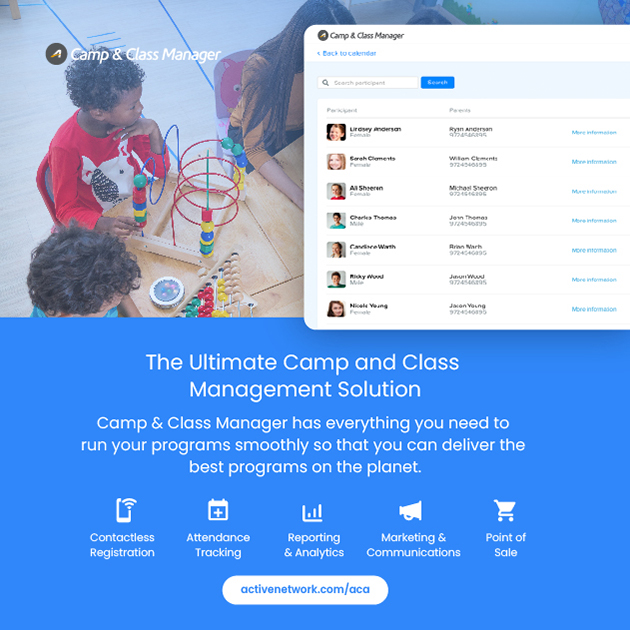A camp job is hard work. Camp is so worth it, as evidenced by all the positive outcomes research has shown campers achieve. But that does not make the job any easier — especially for the teenagers and young adults camps employ, who may be vulnerable to the ever-increasing mental health crisis in the United States. So it is important to check in with staff all season long to make sure each and every one of your employees is in a healthy state of mind.
A Recent History of Mental Health Issues
The National Institute of Mental Health (NIH) describes a mental illness as “a mental, behavioral, or emotional disorder” that “can vary in impact, ranging from no impairment to mild, moderate, and even severe impairment” (NIH, n.d.). This can include anxiety disorders, depression, bipolar disorder, and more.
In 2019, nearly one in five adults lived with a mental illness (NIH, n.d.). In the past two years, that number has grown exponentially. A Morbidity and Mortality Weekly Report (MMWR) released by the Centers for Disease Control and Prevention (CDC) in April 2021 states that from August 2020 to February 2021, the percentage of adults with recent symptoms of an anxiety or depressive disorder increased from 36.4 percent to 41.5 percent. And those reporting an unmet mental health care need increased from 9.2 percent to 11.7 percent. The largest increases were among 18- to 29-year-olds and adults with less than a high school education (Vahratian et al., 2021). The CDC’s Household Pulse Survey, which has gone through several phases of data collection, shows that between August 4–16, 2021, 45.8 percent of respondents ages 18 to 29 experienced symptoms of an anxiety disorder or a depressive disorder (CDC, 2021).
In light of these increasing mental health issues among the age group most likely to fill seasonal positions at summer camps, it’s critical that camps prioritize staff mental health.
To have mentally fit camp staff, your camp needs to provide a mentally healthy environment. The following tips can help you create and maintain an environment that will help promote staffs’ mental well-being.
Start from the Top
Championing mental health is a crucial first step in creating an environment in which staff members can be open about their own mental health. A recent Organizational Dynamics journal article focused on creating work environments that facilitate and maximize the benefits of disclosing mental health problems in the workplace. It suggests that managers “share their own experience with a mental health problem, how they have tried to cope with it, and especially how support provided by others (or their lack of support) had an important impact on their ability to cope with the problem and contribute at work.” Furthermore, evidence shows that staff look up to leaders who do so — and managers who share their own struggles demonstrate courage and make it easier for employees to discuss their own mental health (Bonaccio et al., 2019).
The article also suggested that leaders should share stories about times when other staff members disclosed their mental health issues and received reasonable accommodations. Doing so assures current employees that they can receive support and still fulfill their work responsibilities (Bonaccio et al., 2019).
Get to Know Your Staff and Regularly Check In
Regular check-ins with individual staff members are an important part of prioritizing mental health. Checking in with staff members in a genuine way helps to open the line of communication, giving you a better understanding of how the employees are doing (Carl, 2021).
Checking in with staff may also make them feel more supported and cared about. One workplace study showed that nearly 40 percent of global employees said no one at their company has ever asked them if they were doing OK. Those respondents were 38 percent more likely than others to say their mental health had recently declined (Greenwood & Kroll, 2021).
Check-ins can be formal or informal. “You can make it a part of staff meetings, general check-ins, highs and lows throughout the week or throughout the camp session. Celebrate those personal and professional highs, but then also talk about the lows” (Carl, 2021).
Another benefit of regular check-ins is that as you get to know each staff member, you learn more about their personality and behavior — knowledge that will help you spot any potential warning signs if they begin to struggle (Carl, 2021).
Be Proactive
If you have staff members who might be struggling with their mental health, don’t wait for them to come to you. Talk to them before it becomes a bigger problem. “If you’re checking in when you start to see somebody struggle, you can hopefully . . . get somebody the support, the resources they need. Give them maybe five minutes here or there, versus when it’s a real problem, you’re now talking about it taking much longer,” says Carl (2021).
Think of mental health concerns as you would a physical ailment. For example, if you push through a cold and don’t take care of yourself, you end up with a worse problem later that may require taking time off. If you rest and take medication when you start to feel sick, it may only last a few days. The same goes for mental health — if you start treating the issue early, you often can stop the problem before it progresses into something more serious (Carl, 2021).
Offer Support
As champions of mental health, be prepared to offer support to staff members in need.
If you tell staff members to come to you when they are struggling, be prepared to follow through and listen when somebody does come to you — but it is OK (and important) to set boundaries for this interaction (Carl, 2021).
Following are some options for supporting staff while camp is in session (Carl, 2021):
- Set daily intentions
- Keep a whiteboard in the staff office with items of inspiration and notes of gratitude
- Have a wellness champion
- Promote digital mental health tools
Signs a Staff Member Is Struggling
Because camp is a 24/7 job — aside from scheduled time-off — it is reasonable to expect that some staff members might experience burnout.
Burnout is described as “a state of emotional, mental, and often physical exhaustion brought on by prolonged or repeated stress” (Psychology Today, n.d.).
The following warning signs may indicate that a member of your staff is struggling emotionally (JED Foundation, n.d.):
- Changes in behavior
- Not participating in activities they usually enjoy
- Isolating themselves
- Communicating less than normal
- Sleeping more and still seeming tired
- Being less productive
- Eating differently (overeating or eating less than usual)
- Showing impaired judgment
- Changes in appearance
- Neglecting hygiene
- Looking tired or sad
- Showing dramatic weight loss or weight gain
- Changes in mood
- Having trouble coping
- Stressing more than usual
- Overreacting to situations
- Becoming sad, irritated, angry, or aggressive more easily
- Changes in what they say
- Saying, “I don’t feel well.”
- Asking, “What’s the point?”
- Making negative comments about their appearance
Questions to Ask to Identify Burnout |
|
If you suspect a staff member may be having an issue, these questions from the Mayo Clinic (2021) can be used to help identify burnout:
If the staff member answers yes to any of these questions, they may be experiencing burnout. Again, it is important to have established a good rapport with your staff members and to champion mental health so they will answer your questions honestly. Be sure to reassure them that answering frankly will not get them in trouble but will help determine the best way to assist them. |
What to Do If There Is a Mental Health Crisis at Camp
Even with preventive measures in place, a staff member may still experience a mental health crisis while at camp. It is important to be prepared.
Have a Support Person (or Two)
Choose someone who is close to the person in crisis — perhaps a colleague — to stay with them. Additionally, try to find a person outside of camp, such as a family member, friend, or their doctor or therapist, who can offer support (Carl, 2021).
Utilize Professional Help
If the person in crisis needs immediate care, consider the use of the following (Carl, 2021):
- Mobile crisis units — search “mobile crisis units” and your county online
- Crisis lines
- National Suicide Prevention Lifeline, 800-273-8255
- Crisis Textline — text “home” to 741741
- Local hospitals
Have a Plan in Writing
Your plan should include the mental health resources already noted, plus any procedural changes. For example, you should consider not letting the person in crisis drive or supervise kids, as they may be distracted (Carl, 2021).
Having a plan written down can help you stay calm and collected during a crisis, because you will have what you need in front of you and won’t have to rely on remembering protocols.
Follow Up
Schedule time to check in with the staff member after following the crisis plan. Consider their needs — do they need time off of work? “Taking one or two days right then may end up saving significant productivity. They may be more productive when they come back. They may not need as much time coming back” (Carl, 2021). Not allowing them the time they need when they need it may prompt them to take more sick days as the camp session goes on.
Treat this staff member as normally as you would others, but with a little extra compassion and support — you do not want to ostracize them (Carl, 2021).
Additional Resources |
Kaley Amonett is the communications specialist for the American Camp Association.
References
Bonaccio, S., Lapierre, L. M., & O’Reilly, J. (2019, April) Creating work climates that facilitate and maximize the benefits of disclosing mental health problems in the workplace. Organizational Dynamics, 48(3). doi.org/10.1016/j.orgdyn.2019.03.006
Carl, M. (2021, April 15). Counseling counselors: Supporting your staff’s mental well-being [Conference session]. ACA Spring Leadership Conference. Virtual.
Centers for Disease Control and Prevention. (2021). Anxiety and depression: Household pulse survey. Centers for Disease Control and Prevention.cdc.gov/nchs/covid19/pulse/mental-health.htm
Greenwood, K., & Krol, N. (2020, August 7). 8 ways managers can support employees’ mental health. Harvard Business Review. hbr.org/2020/08/8-ways-managers-can-support-employees-mental-health
Mayo Clinic. (2021, June 5). Job burnout: How to spot it and take action. Mayo Clinic. mayoclinic.org/healthy-lifestyle/adult-health/in-depth/burnout/art-20046642
National Institute of Mental Health. (n.d.). Mental illness. National Institute of Mental Health. nimh.nih.gov/health/statistics/mental-illness
Psychology Today. (n.d.). Burnout. Psychology Today.psychologytoday.com/us/basics/burnout
The JED Foundation. (n.d.) Signs your friend might be struggling emotionally. The JED Foundation. jedfoundation.org/resource/signs-your-friend-might-be-struggling-emotionally/
Vahratian, A., Blumberg, S. J., Terlizzi, E. P., & Schiller, J. S. (2021, April 2). Symptoms of anxiety or depressive disorder and use of mental health care among adults during the COVID-19 pandemic — United States, August 2020–February 2021. Morbidity and Mortality Weekly Report. cdc.gov/mmwr/volumes/70/wr/mm7013e2.htm





